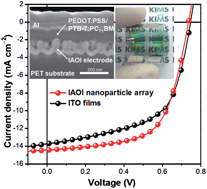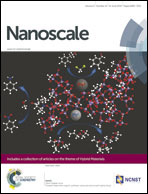Highly efficient and bendable organic solar cells using a three-dimensional transparent conducting electrode†
Abstract
A three-dimensional (3D) transparent conducting electrode, consisting of a quasi-periodic array of discrete indium-tin-oxide (ITO) nanoparticles superimposed on a highly conducting oxide–metal–oxide multilayer using ITO and silver oxide (AgOx) as oxide and metal layers, respectively, is synthesized on a polymer substrate and used as an anode in highly flexible organic solar cells (OSCs). The 3D electrode is fabricated using vacuum sputtering sequences to achieve self-assembly of distinct ITO nanoparticles on a continuous ITO–AgOx–ITO multilayer at room-temperature without applying conventional high-temperature vapour–liquid–solid growth, solution-based nanoparticle coating, or complicated nanopatterning techniques. Since the 3D electrode enhances the hole-extraction rate in OSCs owing to its high surface area and low effective series resistance for hole transport, OSCs based on this 3D electrode exhibit a power conversion efficiency that is 11–22% higher than that achievable in OSCs by means of conventional planar ITO film-type electrodes. A record high efficiency of 6.74% can be achieved in a bendable OSC fabricated on a poly(ethylene terephthalate) substrate.


 Please wait while we load your content...
Please wait while we load your content...